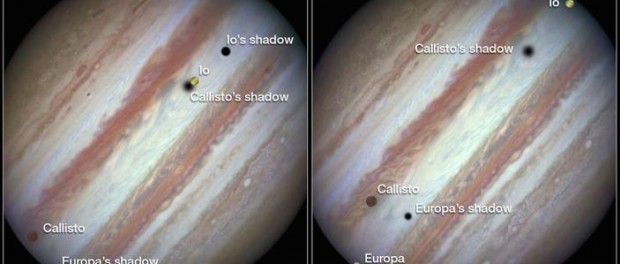March of the moons
 Three of Jupiter's largest moons move across its face.
Three of Jupiter's largest moons move across its face.
The image on the left shows the Hubble observation at the beginning of the event. On the left is the moon Callisto and on the right, Io. The shadows from Europa, which cannot be seen in the image, Callisto, and Io are strung out from left to right.
The image on the right shows the end of the event, approximately 42 minutes later. Europa has entered the frame at lower left with slower moving Callisto above and to the right of it.
Meanwhile Io — which orbits significantly closer to Jupiter and so appears to move much more quickly — is approaching the eastern limb of the planet.
While Callisto’s shadow seems hardly to have moved, Io’s has set over the planet’s eastern edge and Europa’s has risen further in the west.
The movement of Jupiter’s moons has been a hot topic in the past, when scientist Galileo Galilei observed Jupiter through one of the very first telescopes in January 1610.
Over a few nights he saw that Jupiter had four moons and that they moved. (Ganymede is not visible in the photos.) Galileo had trouble convincing other people of what he had seen, though.
Until then, it was thought that the sun, moon, all the other planets and the universe moved around the Earth. It was thought impossible that a planet such as Jupiter could have moons that moved around it.
People weren’t sure they could trust what they saw through his telescope, because they had never come across one before, so they really couldn’t believe their eyes.






Leave a comment